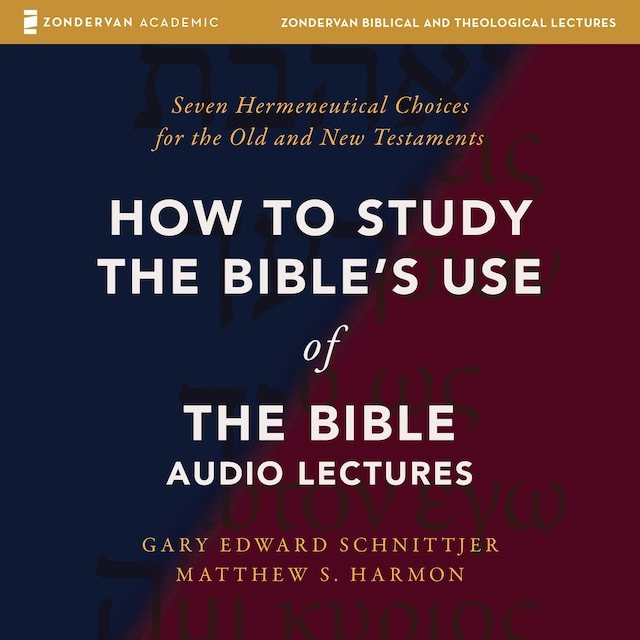
How to Study the Bible's Use of the Bible: Audio Lectures
Seven Hermeneutical Choices for the Old and New Testaments
Description of the book
The Zondervan Biblical and Theological Lectures series provides a unique audio learning experience. Unlike a traditional audiobook's direct narration of a book's text, How to Study the Bible's Use of the Bible: Audio Lectures include high quality live-recordings of college-level lectures that cover the important points from each subject as well as relevant material from other sources.
How to Study the Bible's Use of the Bible: Audio Lectures by Gary Edward Schnittjer and Matthew S. Harmon is an essential resource aimed at teaching a hermeneutic for understanding the Bible's use of the Bible. Intended for students of both testaments, the series' innovative approach demonstrates how the Old Testament use of Scripture provides resources for the New Testament authors' use of Scripture. Lessons provide students with a clear approach to handling the Bible's use of itself through seven key hermeneutical choices organized into individual videos. Each lesson introduces a hermeneutical choice and then provides several examples of the Old Testament use of Old Testament and the New Testament use of Old Testament. The plentiful examples model for students the need to ground hermeneutics in biblical evidence and provide insight into understanding why the Bible's use of the Bible is important.
Session Titles and Runtimes:
0.1 - Introduction: Overview (4 min)
0.2 - Introduction: The Seven Hermeneutical Choices (7 min)
0.3 - Introduction: Definitions (5 min)
1.1 - Sequestered versus Connected: Sequestering the Use of Scripture in the Old Testament (5 min)
1.2 - Sequestered versus Connected: Sequestering the Use of Scripture in the New Testament (7 min)
1.3 - Sequestered versus Connected: The Teachings of Jesus Connect the Use of Scripture in Both Testaments (5 min)
2.1 - Adjusting Meaning and/or Adjusting Context versus Advancement of Revelation: "Jewish" Exegesis in the New Testament (6 min)
2.2 - Adjusting Meaning and/or Adjusting Context versus Advancement of Revelation: Sensus Plenior (5 min)
2.3 - Adjusting Meaning and/or Adjusting Context versus Advancement of Revelation: Advancement of Revelation (6 min)
2.4 - Adjusting Meaning and/or Adjusting Context versus Advancement of Revelation: Case Study of the Use of Hosea 1:1 in Matthew 2:15 (8 min)
3.1 - Detecting Allusions as Art versus Science: Evidence for Allusions (7 min)
3.2 - Detecting Allusions as Art versus Science: Evaluating Evidence for Allusions (7 min)
3.3 - Detecting Allusions as Art versus Science: Exegetical Outcomes (7 min)
4.1 - Horizontal Context versus Vertical Context: Old Testament Use of Old Testament (6 min)
4.2 - Horizontal Context versus Vertical Context: New Testament Use of Old Testament (6 min)
4.3 - Horizontal Context versus Vertical Context: Interpretive Blends (6 min)
5.1 - Biblical versus Extrabiblical Relationships: Priority of Earlier Scripture over Extrabiblical Parallels (5 min)
5.2 - Biblical versus Extrabiblical Relationships: Misunderstood Context of Extrabiblical Parallels (7 min)
5.3 - Biblical versus Extrabiblical Relationships: Sabbath as an Example (8 min)
6.1 - Backward-Looking versus Forward-Looking Typological Patterns: Nature of Typology (9 min)
6.2 - Backward-Looking versus Forward-Looking Typological Patterns: Forward- and Backward-Looking Examples (6 min)
6.3 - Backward-Looking versus Forward-Looking Typological Patterns: Distinguishing Typology from Allegory and Extended Echo Effect (9 min)
7.1 - Historical Exegesis versus Historical and Prosopological Exegesis: Prosopological Exegesis Defined (7 min)
7.2 - Historical Exegesis versus Historical and Prosopological Exegesis: The Case of the Servant (6 min)
7.3 - Historical Exegesis versus Historical and Prosopological Exegesis: The Case of the Son of David (8 min)
8.1 - Responsible Exegesis: A Way of Life (6 min)
8.2 - Responsible Exegesis: Challenges (7 min)


